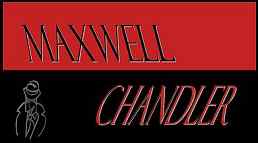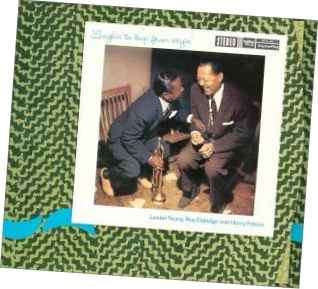
| Maxwell's page three. | ||||||||||
![]()
Sonny Criss Orchestra - Sonny's Dream (Birth Of The New Cool) Prestige Records
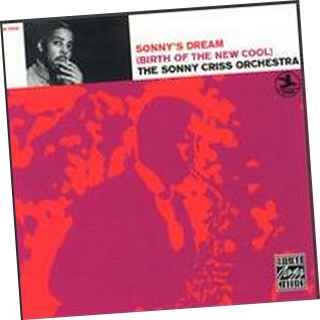
Sonny Criss-alto and soprano saxes
David Sherr-alto sax
Teddy Edwards-tenor sax
Pete Christlieb-bariton sax
Conte Candoli-trumpet
Dick Nash-trombone
Ray Draper-tuba
Tommy Flanagan-piano
Everett Brwon JR.-drums
arranged and conducted by Horace Tapscott
Third Stream music is an amalgam. Depending on who you ask, Third Stream was symphonic/orchestral music with jazz instruments and at its best some of jazz's spontaneity. Or it was Jazz taking it self seriously, picking up the mantle of American Classical music but leaving room for "in the moment feelings" to be responded to during the soloist parts. Such a stew could only have been cooked in America, then the great melting pot.
Either way, it is directly descended from the Twentieth Century/Modernist composers. Both Debussy and Ravel had pieces orchestrated for alto. Shostakovich, Kurt Weil and members of French composers group Le Sixe would use the vernacular of jazz rhythms and instruments to varying degrees of effectiveness in pieces.
The very first appearance of Third stream as a cohesively formed idea was Birth Of The Cool. A ground breaking album released under Miles Davis's name. It was not instantly hailed as a classic, nor was it completely understood right away.
Miles had been playing trumpet with Charlie Parker. Night after night of God-like improvising could loose it's thrill when done in what was quickly becoming simple/standard arrangements.
Gil Evans was doing arranging for the progressive big band of Claude Thornhill. He asked Miles for use of his song Donna Lee. Miles agreed on condition of being allowed to study the charts. This was the beginning of their association. After many informal get together Miles was able to put together a nonet. The main goal being to keep the vitality of what he had seen in jazz ensembles, while naturally fusing it with more complex symphonic-like arrangements. A change in the tone and the rhythmic role of may instruments was also sought.
Birth Of The Cool is enjoyable album still and important in the history of jazz and its evolution. Within this one ensemble you had the seeds of West Coast Cool (Gerry Mulligan, Lee Konitz), the chamber jazz of Modern Jazz Quartet (MJQ's Kenny Clark and John Lewis both being present) and some main Third Stream progenitors (Gunther Schuller, Kai Winding)
Considering that this 1949 recording had no blueprint to work off of save that of what was in the minds collectively of this ensemble, it stands the test of time pretty well. However, there would be Third stream albums to come after this in which I find a deeper fusion of the two seemingly divergent musical genres, symphony and jazz. Sort of unfair to criticize Birth since it was the first and also had limitations as far as the technical aspect of its conceptions go (time length for recording etc.).
Third Stream is now neither as rare nor as misunderstood as it had been. Still, all Third Stream music seems, sub categories aside, to fall into one of two camps. It all leans towards the more big band concept (Gerry Mulligan's Village Vanguard Orchestra) or the more symphonic (Charles Mingus's larger ensemble works).
This album is in the vein of the later.
Sonny Criss came out of the Central Avenue Los Angeles scene which also gave us Charles Mingus, Eric Dolphy and Sonny Clark. Before being signed to Prestige in the 1960s he cut many albums, unfortunatly they were recorded on mainly minor labels making them hard if not impossible to find. Of his Prestige albums this is his most complex.
This was the only album Sonny did not record in New York, staying close to his L.A comfort zone. Like the first Birth Of The Cool album, this ensemble too came out of informal jam sessions (held at Grant's Music Center in Watts, L.A.) Also like the first Birth album this orchestra favors solely the wind instruments. There in lay the only similarities though. These sessions held nineteen years later were done with drastically different technology available. The songs are allowed to stretch out longer than could have been imagined back in the forties.
Some of the piece could easily have been written by Charles Mingus with the appearance of many smaller motifs occurring within one larger piece without ever losing its coherence.
The use of all wind instruments recalls not only the larger pieces by Charles Mingus but also musical Third Stream forefather Gil Evans. Gil Evans genius lay in the (then) unique groupings within the body of the orchestra. While this made for some original music, I always get the feeling that without a lead soloist, his arrangements would not be as compelling. That is not true with Sonny's album.
Despite lack of one specific program, there is an overall feel of dark sensuality reoccurring throughout out the album. The smoky amber of a whiskey and the burnished wood of the bar it sits on.
This was the most, and sadly only forward looking work by Sonny. Thanks largely to Horace Tapscott. Horace Tapscott started on piano and then switched to trombone. His only tour was with Lionel Hampton Band. Illness forced him to give up trombone and go back to piano. A stay in the army inspired him to start arranging and then he too got involved in the Central Avenue scene. He intuitively knew how best to use Sonny's talent. The whole band compliments each other well. Remaining both tight and dramatic on every cut.
The title track finds the band, particularly the rhythm section, laying down a repetitive pulse which allows for Sonny to solo to maximum effect. Hardbop verging on free in attack, in both tone and playing there is a fluidity of ideas carried out with surgical precision.
Ballad For Samuel finds the tubas providing a near waltz like rhythm until the song abruptly changes tempo half way through. A similar technique as found on Charles Mingus Things Ain't What They Used To Be off of Mingus Dynasty.
Daughter Of Cochise has pianist Tommy Flanigan providing a percussive, tinkling, almost celestine attack mirrored by the percussion which gives the effect of Western instruments playing Balinese Gamelon music.
The entire band had strong background above and beyond the standard jazz. This comes through in the seamless performance. Of interest is the fact Al McKibon is on bass as he was with Miles 19 years earlier.
Although this release has not been given any deluxe remastering the sound is pristine. There are two bonus tracks, alternate takes of the title track and The Golden Pearl.
There are few Sonny Criss albums now available. They are all very good, this even one more so given its unique artistic vision and scope. I highly recommend this.
-Maxwell Chandler- May 05
Hear samples or download tracks via Emusic.com
![]()
Lester Young/Roy Eldridge/Harry 'Sweets' Edison
Laughin to Keep From Cryin (Verve Master Edition)
Lester Young-tenor sax
Roy Eldrideg/Harry 'sweets' Edison-trumpet
Hank Jones-piano
Herb Ellis-guitar
George Duvivier-bass
Mickey Sheen-drums
Lester Young, dubbed 'The Pres' (short for president) by Billie Holiday, it was a fitting title to separate such a distinctive voice from other jazz royalty ,the Dukes and Counts.
He was one of the holy trinity of first great tenor men along with Coleman Hawkins and Ben Webster (some would also include Illinois Jaquet, if for nothing else, his solo on Lionel Hampton's seminal 'Flying Home')
He had earned a reputation early on with King Oliver's band and Walter Page's original Blue Devils. Count Basie's band of the early thirties is when his name along with Coleman Hawkins became a Rosetta stone for fellow tenorist.
His father had been a music teacher and also fronted several working bands, some of which Lester Played in. Initially he had played several other instruments including Alto Sax. This, with an inherent genius allowed him to develop a distinct style and sound. Delicate ghost like notes, puffs of blue smoke which eventually dissolve even as they drift away.
I came to an appreciation of Lester Young well after discovering Coltrane and the many other jazz Olympians who came up in the 1950's. It could be because of this or maybe just a generational thing, but I have always enjoyed Lester Young's later, small ensemble stuff far more.
The final years of Lester Young's professional output are his most controversial. No matter how you feel about that last flurry of albums the opinion is bound to be strong.
Towards the end he radiated that type of temporal beauty that the poet Keats often wrote about. A setting sun, a withering flower. A crumbling icon breathing his last breath into his horn.
This album was his last and is rich with (many) emotions which gel nicely with the ever present underlying sense of melancholy. The whole band plays well and there is much joy and romanticism to be found in the duel trumpets of Press's two big band
brother in arms. Despite being a last hurrah for Pres they both sound as strong as they had decades ago.
Norman Granz who gave many of the big band era players a sort of Indian Summer produced this album. For Pres I think it is one of his strongest later efforts. Here he had players with whom he had an emotional connection or who were artistically sympathetic to his style and vision. Hank Jones is a far more logical choice for the piano chores than some of the people who appeared on other Granz produced sides by Pres (Teddy Wilson being the exception) Musically Hank always knew when to back off, a musical pet peeve for Pres with pianist. Yet when he comes in it is swinging, clear and bluesy a perfect percussive counterpoint to the front line of horns. Even though the piano is not prominent throughout a piece, there is nice interplay and you never get the feeling that it was just an after thought put in so the other musicians could rest a few bars.
The drummer and bassist I am not familiar with, but prove themselves to be more than up to the task. They play with a graceful simplicity which was about all that was needed considering what else is going on.
Herb Ellis I have heard in similar settings. He provides depth of space akin to what Freddie Green did for half a century with Count Basie.
The sound is pristine, having been remastered in 20 bit K. The liner notes where mysteriously missing from my CD, but that was factory fluke. There are two bonus tracks a ballad medley and the often sung by Billie Holiday 'Mean To Me'
Another treasure offered up on this disc of Pres playing clarinet again after some twenty odd years on two tracks. There are no weak tracks here, all of them being generous in length varying from seven minutes to twelve.
In his final years his playing still posses that shimmering cloud quality he pioneered, his artistic signature, but gone was all artifice. With this new minimalism he said only what need to be said. Now stripped down to the purest emotional components, the message was made all the more powerful.
The whole album has a feeling of both a goodbye and a valentine. I would not say a summing up so much as reiterating what was important to him, what he will remember and what he will miss.
One of his last musical statements and one of my favorite tracks is 'They Can't Take That Away From Me' Press's solos seem to crumble even as the band tries to hold the delicate threads of the song together. It is sad, beautiful and perfect, conjuring up for a final time the man who became the avatar of both his art and the mood it always managed to convey.
-Maxwell Chandler-July 05
![]()
Ornette Coleman - Skies of America (Columbia/Legacy)
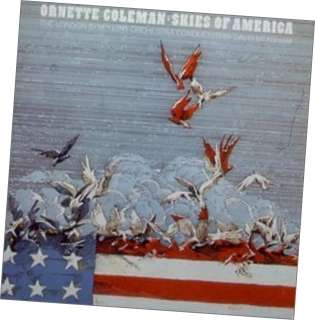
Ornette Coleman-alto sax
The London Symphony Orchestra (David Measham conductor)
A word I try not to use too often for fear of devaluing it is genius. In the jazz world there are many players, composers arrangers and even a few producers who are brilliant. Genius how ever you could count on one hand. A recipient of a MacArthur “genius” award (1994), an induction into the American Academy of Arts and letters, and the first recipient of a Guggenheim Fellowship for jazz composition only, Ornette Coleman is one of the few.
Unlike most other people that recognize his genius, I must admit that Ornette is not the first thing I automatically reach for every day. For me he is akin to a Truffle. Dark, powerful, mysterious in its fecundity and meant to be enjoyed a little at a time to better savor its rarity.
That is not to say this is not important music. This is actually one of the most important pieces of Modern American art, and unlike a lot of others (in various mediums) it does not largely derives its power from the “shock of the new”. An odd sort of irony is that this manages to be both one of his most accessible works on account of its lack of major free jazz discordance, but also one of his most complex.
The copy of the album I purchased was the new remastered version. The sound is pristine. You hear all the high and low ends no matter what your stereo set up may be. This is the 1972 version and the only commercial recording. This piece had a troubled birth. It was originally supposed to be orchestra with Ornette’s band. A concerto grosso. Due to archaic English union laws the band was not allowed to play, the form and scope of the piece slowly changed. Ornette was only allowed to play having been declared on his work permit/visa a concert composer as opposed to musician.
This work had three incarnations before Ornette moved onto different artistic avenues including a trip to Morocco to live and play in the mountains with The Master Musicians of Joujouka. The album was originally broken up into twenty one “songs” in an attempt to get airplay on the radio. Aside from being a bad idea, this is why the piece is sometimes described as a twenty one movement chamber piece or symphony when in fact it is actually a one movement symphonic tone poem. Aside from cleaned up sound they have gotten rid of the brief dead spaces between each “song” restoring it to its one piece unity which provides a far better cohesiveness and is also what the composer had intended. Another misconception is that this piece is sometimes referred to as “Third stream”
Unlike most third stream music this piece does no forgo stringed instruments. And the orchestra is not just providing a canvas onto which the soloist may paint. Ornette himself makes a very brief appearance during the duration of the piece. Out of twenty one tracks he is heard only on 11,14-19 and 20. In his solo statements listen closely he briefly quotes and morphs “I only have Eyes for You”, “Stranger in Paradise” and most importantly “Rhapsody in Blue” This is all done without irony and without any sense of gimmick. The Gershwin quote is appropriate since they were kindred spirits in their artistic comments on modern American life. For Gershwin, man had just begun the modern age. Conquering the sky with both buildings and air travel. There was the promise of lives made easier, things more efficient by the burgeoning modernity, yet there was also a vague apprehension over what we could possibly be loosing. Trading in soul for easy comfort. A generation later and the same issues come up in Ornette’s era. Despite unease both too managed to convey and mix a dose of beauty in with the anxiety.
This truly is modern classical and could easily be mistaken for a piece written by Edgard Varese (1883-1965) or even Petrushka era Igor Stravinsky (1882-1971)
The first most immediately striking aspect of the piece is symphonic timpani beating out poly rhythms alongside a jazz drum kit. A simple but most effective device which I am surprised is not used more often. The orchestra does a fantastic job and give the effect of knowing the piece and what the composer was aiming for as opposed to just playing the charts. Even so, the good job the percussion does makes me lament the fact that Ornette’s usual drummer is absent from this recording.
There are titles for each little “section” but they were put on very much as an afterthought and one should not read too much into the titles. Even without knowing what the album is about, it is rich in mood. The jagged lines and rhythm of the strings manage to create tension but also become sort of mesmerizing. Bubbling up now and then like a new idea are little trios of winds, sometimes all low, sometimes mixing higher pitched reeds with their more mellow sounding brothers. There are tempo changes which are done under many layers of instruments that you feel the effect but do not notice as this device is used. The piece ends in an intricate web of unresolved tensions. This is by no means a Sunday brunch soundtrack. It demands attention and perhaps a connoisseurs palate. The first day I got this CD I listened to it four times back to back. Each time I felt as if I was moving further back from a giant mosaic which allowed me to more clearly see the whole picture.
In jazz brilliance is good too, though genius trumps and is rarer. If you are into good music, deep music then do not worry about labels, pick this up.
-Maxwell Chandler- Sept. 05
Recommended artistic forefathers:
Igor Stravinsky
Petrushka/The Rites of Spring
The Cleveland Orchestra (Pierre Boulez conducting)
Edgard Varese
Ameriques/Arcana/Deserts/Ionisations
The Cleveland Orchestra (Pierre Boulez conducting)
![]()
Fats Navarro and Tadd Dameron -
The Complete Blue Note and Capitol Recordings (Blue Note Records)
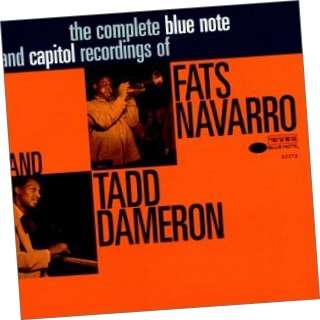
Trumpet: Fats Navarro, Miles Davis, Howard McGhee
Alto Sax: Ernie Henry, Sahib Shihab
Tenor Sax: Charlie Rouse, Allen Eager, Wardell Gray, Dexter Gordon, Sonny Rollins Baritone Sax: Cecil Payne
Piano: Tadd Dameron, Milt Jackson, Gene DiNovi, Bud Powell
Bass: Nelson Boyd, Curly Russell, Tommy Potter, Clyde Lombardi
Drums: Shadow Wilson, Kenny Clarke, Roy Haynes, Mel Zelnick
Congas/Bongos: Diego Ibarra, Vidal Bolado
Trombone: Kai Winding, J.J Johnson
Vocals: Rae Pearl, Kenny Hagood
Clarinet: Benny Goodman
To some extent all taste, or lack of, in jazz is subjective. For the serious and casual fan alike, often the initial favorites and the reason why they occupy that space, is usually of a personal nature. I remember, the way one would a first kiss, the first time I heard Thelonious Monk and John Coltrane. You may keep those first favorites, but most likely you will also listen and learn. Expand your palate.
Some jazz musicians are important because they used a personal vision to create a new way to play their instrument, influencing to varying degrees, everyone who would come after them. (Charlie Parker) Others would write songs that would become standards, the lexicon of this American classical (Duke Ellington). And rarely there would be a combination of the two (Thelonious Monk). All these types of cats were important. Of course there are some that were "merely" good. What slot someone fits into and why, can make for a stimulating night of friendly arguing. The passage of time can also change history's perspective of someone's place in it too. And not always for the better.
Fats Navarro and Tadd Dameron both suffer from this phenomenon.
Fats Navarro (1923-1950) is being buried by time. He started out in The Howard McGhee big band. After meeting and hearing Bird and Diz, it opened up a new world of sonic possibilities for him. He initially worked off of what had inspired him in Diz's playing. So much so, that when Diz left the Billy Eckstein band he was hired, at Diz's recommendation, as the replacement trumpet.
He very quickly created his own sound off of what had initially musically freed him. 1946 saw him popping up on tracks by such early giants as Coleman Hawkins and Illinois Jacquet. 1947 was his first date as a leader in his own right. All the compositions on his first date were original save for one.
The importance of Fats is threefold. He did write some standards (Boperation et al). He was one of those trumpeters who could convey and combine technical prowess with emotion, although he never soloed on a ballad (on record). Fats inspired many who would follow closely on his footsteps. He was artistic fuel for the hard-bop trumpeters and the beautifully aggressive splatter school of trumpet playing, (Clifford Brown, Lee Morgan, Freddie Hubbard). One of his last acts was playing with and encouraging a slightly younger Clifford Brown (also gone way before his time). Unfortunately Tuberculosis further aggravated by the club land lifestyle, alcohol and narcotic abuse took its toll. Fats, a giant of a man and artist reduced to only one hundred pounds in his final days.
One problem with Fats' artistic legacy was how briefly he was around in his own right as a featured player/leader. He was not around long enough to crystallize his ideas for new schools of music ala peer Miles. Nor did he leave behind too large a body of work. The longer playing records were just appearing as Fats was bowing out. To a younger crowd just discovering jazz (now) they may appreciate Fats? tone and attack but have grown spoiled by some of Impulse labels stars who could get twenty minute solos to journey with the audience on. Clifford Brown fares a little better, benefiting from appearing on some classic Blue Notes but also having had his own permanent band with Max Roach.
He had been co-soloist with every major bop trumpeter. For what ever reason, and despite the talent both established and upcoming which Fats could get, he never had his own permanent band. His most important and longest partnership was with musician/composer/arranger Tadd Dameron.
Tadd Dameron (1917-1965) started as a big band arranger. It was after meeting Bird and Diz his eyes were opened to a longer, more lyrical freedom in smaller ensemble forms.
Although it had not been around for terribly long, bop was losing the audience and market which big band had fostered. Bop was feverishly embraced by those in the know, bohemians and fellow artists. The burgeoning middle class was soul weary after the war. They had some money to spend and wanted to be entertained. Many of the bop artists saw themselves not as entertainers, but as artists and demanded to be treated so. Not always the easiest thing to do in a still largely segregated America.
Because of war time shortages too, a lot of the birth of bop was not caught on record. It was the start of modern advertising, giving people the message of what to buy, what to enjoy and how. 1940's Capital Records would make some records of what was going on now. Whet the public's appetite and bring them back for more. They chose Miles Davis and what would become "The Birth Of The Cool" and three days earlier the seemingly safer bet of Tadd Dameron's Octet/Nonet.
What is interesting is how important the initial carriers of the bop message and style were but also how quickly it became formulaic. Even still, there is excitement to be found in hearing many of those solos, but very quickly an attentive listener will hear the repetition of a pattern in all the songs. Working in tandem Miles and Tadd set off on similar missions, with Tadd emphasizing the possibility of beauty, Miles a new classical complexity. At some points both men shared and fueled their works with the same collaborators (J.J Johnson, John Lewis, Milt Jackson). Tadd's most sympathetic partner and the one whom he achieved some of his greatest triumphs with was Fats Navarro.
When Fats' drug habit finally got the better of him he demanded too high a fee. The man who often wrote the musical words his voice would so eloquently speak could no longer afford to hire him. Ironically he would replace Fats with a young Miles, both of whom had played and sat at the feet of Bird. This was the permanent rift which would never heal. After Fats' death Tadd moved to England for several years. Upon his return to the states he worked in Atlantic City, creating every aspect of a floor show there and also hiring Clifford Brown for the band. A drug habit sent him to jail. While in jail he wrote charts for an album by Blue Mitchell. Upon his release styles had greatly changed. It was easier for longer works of greater complexity to be recorded and noticed. Tadd did some arranging for Sonny Stitt and Milt Jackson.
In 1962 he had his first album under his own name since 1956, The Magic Touch. Unfortunately it was also his last artistic statement, being claimed by cancer shortly after this initial promising release.
This is a double CD. Aside from a few tracks here and there under other artist names this is Fats' entire oeuvre. It contains some previously unissued alternate takes. There is a proper box with similar packaging which adds two CDs, mostly pre-bop dates with Fats on them and forgoes the alternate takes. Good for the completionist mainly.
The sound quality on both discs is very good to great. All tracks are in stereo and recordings were transferred through the Cedar de-clicker. A device which improves sound dynamics eliminates unwanted pops and hisses. This process is actually an art and science unto itself (Louis Armstrong's The Hot Fives and Sevens boxed set received the same treatment).
The tracks are divided up by sessions dates with subtitles telling you what session/ensemble it is. Included are the sessions Tadd did without Fats (Miles taking over trumpet duty) and some dates Fats did without Tadd (Kenny Clark or Bud Powell on piano). Neither artist comes off weaker without the other. The tracks seem to appear in chronological order. My only bone of contention with this otherwise engrossing CDs is the way the tracks are set up. Bonus tracks of the same song appear immediately after the first version. If, for what ever reason you do not have ability to program the stereo or press skip then you must sometimes listen to three versions of same song. A better design would have been what Verve has done with many of the Bird reissues. Have the original album as it appeared, then all the bonus tracks. The bonus tracks are by no means waste of time though, they are more than just the false starts that other artist include as "bonus" material.
There are a few songs with vocals which are not that compelling. It would have been great to have gotten a chance to hear Fats with a singer of the same caliber as when Clifford Brown made an album with Sarah Vaughan. Overall the tracks all stand up, none of them have that "old timey" feel compelling only to the specialized aficionado.
A treat too, is hearing some of the second wave of greats at their start. My favorite tracks feature Bud Powell with a young Sonny Rollins (who managed at the start of his career to play with both Fats and Clifford Brown). The Bud Powell tracks are also interesting in their conception. Bud seemed to usually prefer the trio format, but here he has what would become the jazz standard of the tenor-trumpet front line.
The elusive Ernie Henry (alto sax) is on some tracks too. He was rarely to be found in the studio and had been featured (along with Sonny Rollins) on Thelonious Monk's aptly titled Brilliant Corners. At the time when most alto players were aiming for that soaring-liquid Bird-like sound, Henry was his own man. Instead opting for a darker, more aggressive sound.
The last track is Fats with Benny Goodman. By today's standards it does not sound as "modern" as it was intended, but it manages to transcend mere novelty.
By his own admission Fats' lifetime was spent in pursuit of an original, perfect melody. Tadd first and foremost was concerned with beauty. Propagating it through music and here, through the melodies of his partner caught too briefly on these tracks for us all to enjoy.
Maxwell Chandler-November '05
![]()
Donald Byrd - Fuego (Blue Note Records)
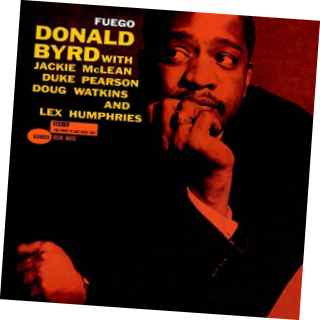
Donald Byrd: trumpet
Jackie McLean: alto sax
Duke Pearson: piano
Doug Watkins: bass
Lex Humphries: drums
In the 1960’s a lot of the Blue Note albums were of the hard bop genre. They had a steady stable of artists and each album would often feature the same core line up over several albums with a change, maybe, being made on the front horn line or with the addition of an instrument. During this period the list of personel on these albums reads like a hard bop hall of fame, a who’s who. This was before any traces of gimmick or ego.
This album is a further celebration of a three way partnership which birthed many memorable albums and live dates and an introduction to a soon to be important jazz figure.
At 23 Donald Byrd had met Jackie McLean when they shared the front line for a Café Bohemia gig in George Walington’s quintet. Also present at this beginning was bassist of choice Doug Watkins.
Donald played on Jackie McLean’s first album, as did Doug Watkins. While Jackie McLean was apprenticing under Miles Davis and the fertile 52nd Street scene Donald Byrd and Doug Watkins were members of The Jazz messengers. Together all three appeared in various configurations on albums under others names (John Coltrane, Red Garland, Lou Donaldson).
After separating to play on the road, the trio made up the core of bands found on Jackie McLean’s New Soil (Blue Note) and Donald Byrd’s Off to the Races (Blue Note).
This loose based trio only came to an end when Doug Watkins was killed in a highway accident in 1962. Aptly, his final musical statements being made on Jackie McLean’s Bluesnik (Blue Note) and Donald Byrd’s Chant (Blue Note).
Further adding to what would already be a rewarding experience for the listener is the recording debut of Duke Pearson. Duke Pearson presented one of the all too rare phenomenon’s in jazz of the triple threat: Musician, composer and arranger.
In the future he would lean more heavily towards the arranging and compositional aspects of his art. The chemistry he helped foster here would get him his own recording contract. In quick succession he would record four albums under his own name, all of which used this session’s drummer, Lex Humphries. The compositional and arranging aspect seemed at times more rewarding for him. Although Herbie Hancock would sit in the piano chair, he did all the arranging for Donald Byrd’s ground breaking album A New Perspective (Blue Note) and the harder to find I’m Trying to get Home (Blue Note).
Following in the footsteps of fellow musician Ike Quebec (tenor sax), he became Blue Note’s production line liaison. This did not stop him from the occasional collaborations though. In the early 1970’s he played electric piano when Donald Byrd switched over to funk with his band The Blackbyrds.
An amicable parting left Duke to form his own forward leaning big band comprised of many members of already famous big bands such as Count Basie’s New Testament era band. Such a pedigree allowed them to easily follow the complexities of Duke’s charts. After many successful tours he would go on to teach at Clark College, several times reviving his big band, always managing to get the original members.
Late in the 1970’s complications from MS made performing and the road life it eschewed too difficult. While his presence would dwindle, his voice typified by some unforgettable songs and arrangements would not.
This CD was a Blue Note RVG (Rudy Van Gelder) edition. They take some classic albums and have had the original engineer go back and clean them up, correct pitch etc. The sound on these versions are always pristine as is the case here. Although there are none here, these CDs often feature some bonus tracks. The original liner notes are reproduced along with “A New Look At…” section which re-examines the album through the lens of time and the hindsight it offers.
On this album Donald Byrd plays a B-Flat Piccolo trumpet. This gives a mellower, richer sound. Jackie McLean started off as Bird acolyte, but very quickly found his own voice. One of alto sax’s most distinctive. His articulated primal scream is a sort of fierce lament which attains its own poetry. Duke Pearson’s playing is blues based, but with a sort of ethereal quality in both tone and attack. A certain delicacy of touch which adds depth without ever distracting. Overall the entire band plays well. While there is an almost tangible link between the musicians the spontaneity, one of jazz’s most important aspects, is never lost.
For me the stand out tracks are the title track which features the horns playing the melody/theme in unison, harkening back to the golden days of bop, but with an added fire not allowed those pioneers. At this point Donald Byrd was of the splatter school of playing, but with more diversity to tone and attack than many of his peers. The slower numbers never felt belabored or clumsy.
Funky Mama is a blues which starts with a slow smolder. Jackie McLean’s cry is the cry of the night. It conjures up the ghost of a thousand late nights. The cities neon blurring into the dirty concrete of the street. Everyone is happy to be going somewhere, even if it is just home.
Donald Byrd plays with a laughing tone, the marriage of Clifford Brown and Clark Terry. The perfectly titled Amen conjures up images of an old revival meeting where everybody is happy to dance. It is the gospel tinged prelude to a deeper immersion which Duke Pearson and Donald Byrd would pursue together on their album A New Perspective which would also incorporate a choir (The Voices of Coleridge Perkinson Choir) and the Duke Pearson penned Cristo Redentor.
This CD is one of the best examples of what the genre of hard bop has to offer. A complexity of arrangement and the emotional response of the artist offered up to all who will have it.
-Maxwell Chandler-Nov’05
![]()
| Click Here |
Page one of Max's Jazz reviews
